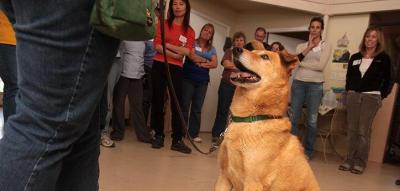
'Look at That' (LAT) Training for Reactive Dogs
Some reactive dogs can get pretty frantic — barking, lunging, pulling on the leash, and generally freaking out — when they see something exciting or scary. Reactive behavior can be embarrassing at best and dangerous at worst. However, implementing “look at that” (LAT) training can help dogs stay calm and safe in these situations. The goal is to have the dog be able to look at their trigger (whatever makes them react) and then look back to their handler while remaining calm.
Steps to teach dogs ‘look at that’
Use the following steps to train a dog to “look at that.”
- Decide on a sound, word, or visual marker that you’ll use to indicate to your dog that they’re doing something great and that a treat will follow. Clickers and a verbal “yes” or “good” are popular markers.
- To teach your dog that the marker always means a treat is coming, click the clicker or say the word and then give the dog a treat immediately. Do this repeatedly until your dog looks expectantly at you whenever you use the marker.
- With the dog on leash, stand at a distance from the trigger. You should be far enough away that your dog sees the trigger but isn’t reacting. As soon as the dog looks at the trigger, use your marker. Your dog should turn toward you in anticipation of the treat. When they do, give them the treat.
- When your dog consistently looks at the trigger without reacting, test to see whether they’ll look back at you in anticipation of the marker and treat after they look at the trigger. If so, mark and then treat. If not, repeat step 3.
- Gradually, one foot at a time, decrease the distance between your dog and the trigger. Continue using your marker and treats if your dog doesn’t react. If your dog starts reacting, simply increase the distance between the dog and the trigger again until the dog is no longer upset. Continue training with the aim of decreasing the distance even more gradually.
Proofing the ‘look at that’ dog training cue
Proofing means teaching the dog to generalize the behavior in different contexts.
It’s important to practice the "look at that” dog training cue often. When you start, practice in the same environment — someplace that is low stress for your dog.
Then, you'll graduate to different people handling your dog, as well as with different levels of distraction and in different places. Work with different forms of the trigger, too. For example, if your dog reacts to vehicles, practice around cars, trucks, etc. And if your dog reacts to people, practice around men, women, kids, and so on.
Home starts with you
If your dog is reactive toward other dogs, make sure you are practicing with a calm, nonreactive dog as the trigger at first. Once your dog is consistently doing LAT successfully with the other dog, practice with dogs who are progressively more reactive (always working with the other dog’s handler and maintaining a safe distance).
There is no pressure for your dog to have to get close to another dog! If your goal is to be able to walk down the street with dogs on the other side of the sidewalk without them barking, then you don’t need to push getting close to very reactive dogs. Here’s the continuum of behavior from nonreactive to reactive when you get dogs together in the same area:
- The other dog is calm, ignoring your dog.
- The other dog is calm, occasionally looking at your dog.
- The other dog is calm, looking at your dog.
- The other dog is calm, staring at your dog.
- The other dog is pulling toward your dog.
- The other dog is barking at your dog.
- The other dog is lunging at your dog.
Troubleshooting ‘LAT’ dog training
LAT training can take some time, and there might be setbacks. Here are some troubleshooting tips:
Make sure your dog has no reaction to the trigger when you’re in position to start training. This is called being under threshold, and it might take a little experimenting to find that place. Start farther away than you think necessary, and be patient about moving gradually closer to the trigger.
If your dog is extremely reactive and you can't find a distance outdoors from which they won't react, you can try starting your training indoors.
If a trigger comes upon you unexpectedly while you’re training and your dog starts to bark or lunge, say “let’s go” and do a U-turn, moving away from the trigger until your dog is no longer upset. Be sure not to turn into your dog but rather start walking another direction and lead them with you to avoid any redirection. Once you're at a distance where your dog isn’t reacting, start doing LAT again or ask for behaviors your dog already knows until you have regained their attention.
If you get stuck on any step, stop and take a break. When you try again, go back to the previous step in the plan. If necessary, create intermediate steps with intensity and duration that your dog is comfortable with. Don’t rush; take it at the dog’s speed. Keep in mind that it can take a long time to change deep-seated fears in dogs, so be patient.
